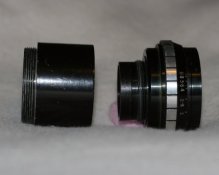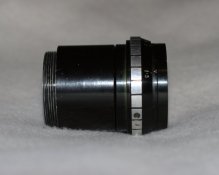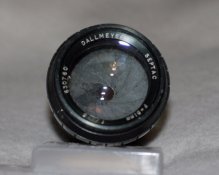By the serial number, yours is quite late -- post-1960 according to P-H Pont's chronology -- so should be coated. The VM has a little to say about Septacs:
"Septac f1.5 20, 25, 51, 76mm for cine.
Of these , 51mm was also mounted for oscillograph and perhaps still work. It was covered by Pat 553,844 and
this is typically engraved on the outside of the front ring. (Note B.Pat No544,694 was granted in 1941approx,
No 575,075 in 1944 approx.) This suggests the Septac was patented early in the war. (This can be checked,
as these dates are from the US equivalents of B.Pats.)
It covers 48°, and 51mm is nice for 18x24mm, but struggles slightly to cover 24x36mm unless closed down a
bit. It is relatively free from flare as there were only 8 air/glass surfaces (an extra glass is used, but cemented
in component 2) compared with 10 on the competing Gauss types. It occurs in M39x26 thread but those seen
had a deeper register, and did not have a protruding coupling flange; and were probably off the Langham-
Thompson Oscillograph camera. They were used for recording by the MoD but the camera is not known.
Alternatively they may be ex-movie. It has been mounted (transplanted to Contax), one at auction being
No265,06x, and this may be easier to use short head lenses this way than converting them to M39 as no
focusing mount is needed. Coated versions were made but are scarce. Several mounts seem to have been
involved. (The leaflet is all about applications in technical recording, not general or movie work.) It was noted at
Nos 369,17x and 470,48x, both uncoated, and one also has the number 178 on the mount, possibly the
number of the M39 camera it matched. <big gap and then another entry>
Septac
It has been difficult to date the introduction of Septac, but one clue may be the Patent Number (below) and
another is the number which are not coated, as Dallmeyer began coating late in the war or soon after it. A f1.5
Coated Anastigmat is noticed in the B.J.A. 1946, p180, and seems to be to a design patented in the warwhich
would fit. It has 7 components (=glasses?) and covers 47° and it has proved its worth in fluorography
and is rated to cover the full 24x36mm format. It was then in standard iris mount only, ie barrel and probably
only as an f1.5/2in This was featured in a note in the B.J.A. 1962, p484-37, and was then in 51mm (2in) for 48°
only, for recording on up to 24x36mm (nb, in close up) and fluorography and radiography, and could be had in
a flange, or plain 42.5mm tube, without iris, or a micrometer focussing mount was available. These will be
'late' coated lenses. They carry the Patent number 553,844 on the side and were often illustrated early
postwar (B.J.A. 1947, p428.)"
All this from the VM gives the very strong impression that it wasn't made to be used as a taking lens out-and-about on any camera contemporary with it. Still worth trying if you can find a camera that it can be adapted to. Maybe an RF Contax, as the VM suggests.













